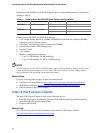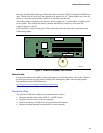Intel Desktop Board D915GEV/D915GUX/D915GAV/D915GAG Product Guide
22
Enhanced IDE Interface
The ICH6’s IDE interface handles the exchange of information between the processor and
peripheral devices like hard disks, CD-ROM drives, and Iomega Zip
*
drives inside the computer.
The interface supports:
• Up to two IDE devices (such as hard drives)
• ATAPI-style devices (such as CD-ROM drives)
• Older PIO Mode devices
• Ultra DMA-33 and ATA-66/100 protocols
• Laser Servo (LS-120) drives
Serial ATA
The desktop boards support four Serial ATA channels via ICH6, connecting one device per
channel.
Expandability
The desktop boards support the following:
• Desktop boards D915GAV and D915GEV
⎯ One PCI Express x16 add-in card
⎯ Two PCI Express x1 add-in cards
⎯ Four PCI add-in cards
• Desktop boards D915GAG and D915GUX:
⎯ One PCI Express x16 add-in card
⎯ One PCI Express x1 add-in card
⎯ Two PCI add-in cards
Related Links:
For information about installing the PCI Express x16 card, see page 41 in Chapter 2.
BIOS
The BIOS provides the Power-On Self-Test (POST), the BIOS Setup program, the PCI/PCI
Express and IDE auto-configuration utilities, and the video BIOS. The BIOS is stored in the
Firmware Hub.
The BIOS can be updated by following the instructions on page 59 in Chapter 3.
Serial ATA and IDE Auto Configuration
If you install a Serial ATA or IDE device (such as a hard drive) in your computer, the auto-
configuration utility in the BIOS automatically detects and configures the device for your computer.
You do not need to run the BIOS Setup program after installing a Serial ATA or IDE device. You
can override the auto-configuration options by specifying manual configuration in the BIOS Setup
program.


















